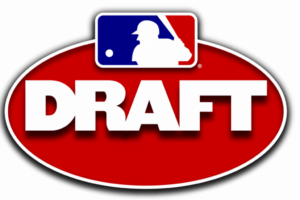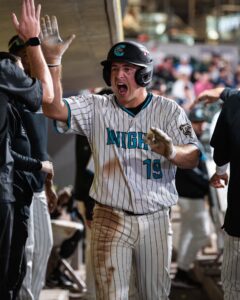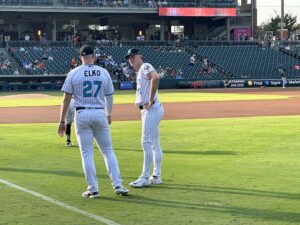In-person report: Winston-Salem Dash prospects, June 2016
These are reports on White Sox prospects I watched late last week in Winston-Salem. I also interviewed a handful of them, and those interviews will be published in a separate article.
The June 24th game included the High-A debut of 26th overall draft pick Zack Burdi, which I covered on it’s own in-depth. Burdi hit a sizzling 102 mph with his fastball, and you should read that article on it’s own.
This article will cover the other prospects of interest that I saw. Videos for some of the players are embedded. Other videos can also be found on our YouTube channel.
The Starter
Spencer Adams, the 3rd-ranked prospect in the White Sox system, got the start on the 24th. This was an important prospect for us to catch in person, not just because he’s a key arm. Adams is not the same pitcher he was at draft time or in the AZL in 2014. In Arizona, having not made any material changes after his high school season, he was throwing a four-seam fastball in the 92 to 96 mph range, and an at-times wicked slider in the mid-80’s. He was also coming from a cross-fire delivery, 3/4 slot but with lots of body rotation.
Now at 1.5 seasons in full season leagues, Adams’ velocity has been down noticeably – he was 89-91 for much of 2015 as he adjusted to increased innings and some delivery changes to get him more north-south. He also came into the system with a somewhat wiry frame, so building up strength and endurance was key. His numbers in 2015 varied, but generally improved during the year, as the adjustments took hold and he got into a rhythm.
Here in 2016, we see the current Spencer Adams. Let’s look at some video from his most recent start, beginning with this at-bat featuring three different pitches…
The delivery is cleaner and more consistent now. The angle is a little higher more of the time on release too, giving him more downhill plane. He’s got better balance, and therefore can now hit his spots more consistently. He threw strikes before, but now he can truly locate on different spots on and off the plate, up and down.
He’s also changed his pitch repertoire. That 4-seam fastball is now in the 90-92 mph range, though he does occasionally rear back for 93 or 94 (but not in this start). But that has become a secondary pitch. What I saw in this start – and what Pitching Coach Jose Bautista told us is now his M.O. – is that his #1 pitch is a 2-seam sinker, which comes in around 87-88 most of the time (though sometimes creeps higher). It’s a somewhat unusual 1-2 combo, but he makes it work in part because he can locate both pitches so well in those ranges and with his current delivery. You can see him work inside and outside, and hit the catcher’s target pretty well. This explains the lower strikeout totals (in this game and generally this season) but better ground ball rates.
Here’s a one-pitch plate appearance giving a good look at that sinker:
Adams also features a slider that came in around 83-85. Command of this pitch wasn’t terribly fine in this start, in location or character (though more so in location). At times it had some big, late bend, but only some of the time. There’s a lot of potential in this pitch, but either he was just having a bad day with it, or it needs further refinement (probably both). There’s also a change-up he showed on occasion in the low 80’s that dropped off the table nicely.
There are two important take-aways here at a high level. First, this version of Adams is not the same as the 2014 version. Second, the guy just turned 20 in April, being 19 for his first start in High A this year. Both these facts should tell you that you can probably throw out much of the top-level scouting data on Adams’ pitches that were written in 2014, and that he’s going to change even further in the next year or two. Spencer is probably not a consideration for the majors until 2018 at the earliest.
Other Pitchers
As noted earlier, the Burdi appearance was discussed in depth here.
The ninth inning saw another Advanced A debut, this one for lefty Ryan Riga. The team’s 13th round pick in 2015, Riga looks like he’s close to the listed 6′ height. He spent 2015 in rookie ball (with both affiliates), as well as Kannapolis. This year they opened with him in the Kanny rotation, likely just to get him the innings and development, which usually hints that the team sees this pitcher as someone with a legit shot as a future major league reliever. He struggled in that role, and after 5 starts he was back in the bullpen, where he was much more effective, resulting in the promotion to a more age-appropriate level for the 23-year old.
Here’s a video where you can get a good look at the two pitches he was using in this outing:
The fastball ran 89 to 91, and had more than your average tail to arm side. This would allow him to run in onto the hands of left-handed batters or grab the back door on the outer edge. His breaking pitch (which I’m not sure what to call, probably a slider) came in around 83-84, and it covered plenty of horizontal ground, but it’s of the sweeping variety. He worked both sides of the plate and seemed to be in pretty good command. Altogether there’s a potential LOOGY profile to work with here.
The Position Players
The Dash have a number of intriguing arms, but the lineup just doesn’t have a lot of future major leaguers. There is one player I’d like to cover, though.
Mason Robbins is probably my favorite deep sleeper prospect in the system. This was my third look at Robbins overall, first in A+. The team’s 25th round pick in 2014, Robbins is in his 3rd year of pro ball, and hit .263 with few walks and little power last year as a 22-year old in the Sally. He’s hit just 12 HR in close to a thousand PA, has stolen 5 bases in that time, and his career OBP stands at a flat .300. In 237 PA so far this year, he’s walked just 4 times.
He is also a prime example of the dangers of stat line scouting in the minors.
Robbins doesn’t steal, but he’s got at least 60-grade speed, confirmed when I clocked him from home to 3rd in 11.8 seconds back in 2015 – you won’t see the extra bases taken or the range in the outfield in the box score. In terms of hit tool, while he doesn’t draw walks, he does consistently work long counts and foul pitches off. He will expand the zone, especially in 2-strike counts – but this is eminently fixable, and in talking with Mason he’s well aware of the issue and focused on improving it. Power? He puts on a decent show of it in BP, but because he extends too much to increase plate coverage, he loses all leverage and has to rely on his hands for power. Which he does – he’ll reach out for a pitch off the outside edge and flick it into right-center for a double or triple. So the raw power is there, if he can stay back and wait for pitches in the zone, which again is a fixable thing. Defensively he’s quite good on the corners with good range and instincts, and in this game he threw a bullet strike in the air to second base from the RF corner. He currently leads the Carolina League in outfield assists with 10.
In short, Robbins has the natural tools to be a major league outfielder. He’s one modification and a base-running green light away from seeing his numbers match the skills. Players like that are the types that have the potential to come “out of nowhere” to be legit prospects. Whether he gets there or not is of course an unknown at this point, but he is somehow hitting .290 with a reasonable 18.8% K/PA rate this year despite being absolutely no threat to walk. Here’s a video of a 7-pitch at-bat worked against Corey Ray, who was throwing a 94 to 97 mph fastball…
Emptying the Notebook
Here are some smaller bits on other players I watched:
- Cleuluis Rondon continues to be a wizard at shortstop, showing off premium range, glove and arm. The story remains the same – if only he could hit just a little bit…
- Hunter Jones put on a power show in BP. He hasn’t expressed that power much in games, but the raw is there, along with premium speed. But he had trouble catching up to mid-90’s heat in the game.
- Brett Austin shows athleticism behind the plate, blocking pitches well and making defensive plays smoothly. He gets in good positions to receive, though he gets a little fidgety back there and isn’t a quiet receiver. The couple throws he made to get base runners weren’t good – a sample size of 2 throws may not be enough to read much into though.
- This could be nothing, but… twice during warm-ups, RHP Euclides Leyer had another player get into a catching position, so Leyer could throw… submarine. Might have just been messing around, though he did it twice for a few throws each.
Want to know right away when we publish a new article? Type your email address in the box and click the “create subscription” button. Our list is completely spam free, and you can opt out at any time.






